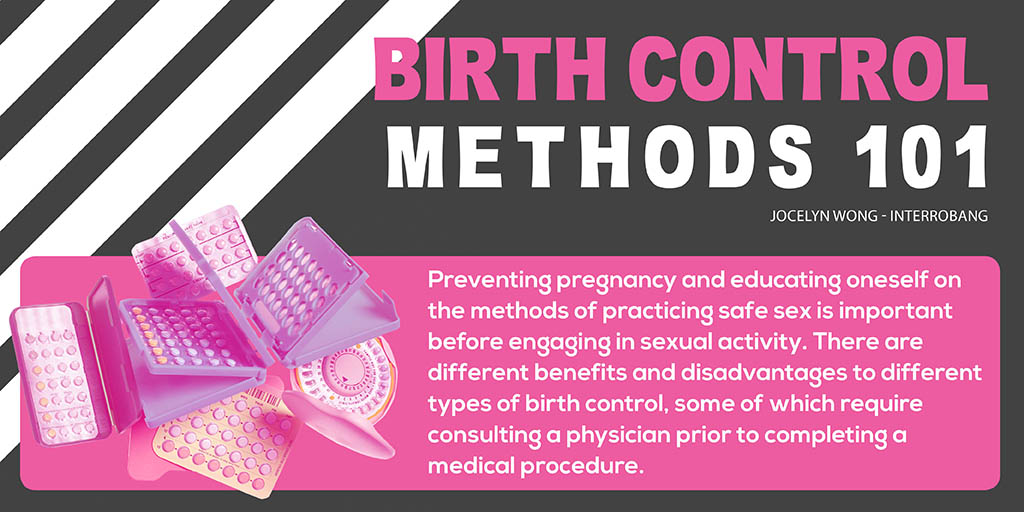Birth Control Methods 101

Preventing pregnancy and educating oneself on the methods of practicing safe sex is important before engaging in sexual activity. There are different benefits and disadvantages to different types of birth control, some of which require consulting a physician prior to completing a medical procedure.
REVERSIBLE BARRIER METHODS Barrier methods are best for reducing the risk of sexually transmitted infections (STIs) and infections in general. This includes cervical cap, diaphragm, spermicidal foam, sponges, film, as well as male and female condoms. It does not affect fertility and does not affect pre-existing health conditions such as high blood pressure. However, it has the highest failure rate in comparison to other birth control methods.
IUD INTRAUTERINE DEVICE A plastic device that is inserted into the uterus and prevents the fertilization of the egg. It is effective for up to five years. There are four types of Intrauterine Device’s (IUD) available in Canada: copper IUD – which is the only non-hormonal IUD and three other types of IUD. They are proved to be highly effective and discreet. That being said, they do not prevent transmission of STIs. To ensure safety, it is highly recommended to practice safe sex with condoms.
HORMONAL METHODS & BIRTH CONTROL PILLS Taken every day, these hormonal pills help stop ovulation – which stops pregnancy. It prevents the ovary from releasing and egg and thickens the cervical mucus to stop sperm from reaching the egg. Oftentimes, the pill regulates menstrual cycles and can help reduce acne, but can also cause spotting and other health issues such as blood clots. If not taken regularly or on time, birth control pill users can still fall pregnant. It does not provide any protection against STIs. Health Canada has reported several quality concerns with Alesse, Alysenal, and Demulen in the last year.
PERMANENT This is the most effective type of birth control method but does not prevent the transmission of STIs.
TUBAL LIGATION This procedure is an invasive surgery where doctors will create incisions in the abdomen to block, tie, or seal the fallopian tubes. There are possible drawbacks to this procedure: it can cause damage to nearby organs, bleeding, scarring, and lower abdomen pain. It also does not offer protection for STIs.
VASECTOMY Rendering a man infertile, this procedure is 99.5 per cent effective in preventing pregnancy. It is a procedure that can be done quickly (about 15 minutes) by a physician. There are two ways to complete the procedure: During the procedure, the doctor numbs the scrotum and makes two incisions to sever the tube carrying sperm to testicles and seals the ends. Another method is to puncture one side of the scrotum and cut the vas deferens. Some side effects include swelling, pain, and sometimes infection. A follow-up appointment is required to do a sperm count, ensuring success. Vasectomies can sometimes be reversed if patients change their mind.
TRANSERVICAL STERILIZATION ESSURE First introduced to Canada in 2001, Essure is a medical device that is marketed to block Fallopian tubes, without any incisions or general anesthesia. Health Canada has reported in 2016 that some complications with the product has resulted in unintended pregnancy, allergic reactions and chronic pain. The product is now banned and discontinued in several countries.
EMERGENCY CONTRACEPTION Emergency contraception is a type of birth control that prevents pregnancy after unprotected sex or failed contraception. Sperm can live up to six days in a woman’s body up to a week and ma lead to pregnancy. Emergency contraceptive methods can help to stop ovulation unless your body has already started ovulating. It is not as effective as other regular methods of birth control and does not prevent the transmission of STIs.
HORMONAL METHODS MORNINGAFTER PIL Similar to other regular birth control pills, it has a higher dosage of hormones in it and do not always require a prescription (ex. Plan B, Option 2, and Next Choice). These pills work best if taken within 72 hours of unprotected sex. It is important to note that height and weight are factors to consider when taking the pill. Anyone with a body mass index (BMI) of over 25 will experience a lower efficacy rate in consuming the medication and should consult a physician before purchasing the product. It is important to note that different kinds of morning-after pills should not be used within five-days of each other as they may counteract each other and can cause unnecessary side effects such as nausea and bleeding.
COPPER IUD This method is 99 per cent effective in preventing pregnancies post-intercourse for up to seven days. This IUD is a plastic T-shaped device that is wrapped in copper wire. It prevents pregnancies by inhibiting sperm mobility in the uterus and only takes under 10 minutes to insert. Some side effects include heavy periods and high risk of pelvic diseases.
PULLING OUT WITHDRAWAL METHOD The least reliable form of contraception, this method has the highest rate of human error and failure. In order for this method to be successful, men must offload their sperm elsewhere. The first burst of semen that emerge from the penis the most potent. This makes it risky if men cannot withdraw immediately before ejaculating; Withdrawal also does not prevent STIs.














